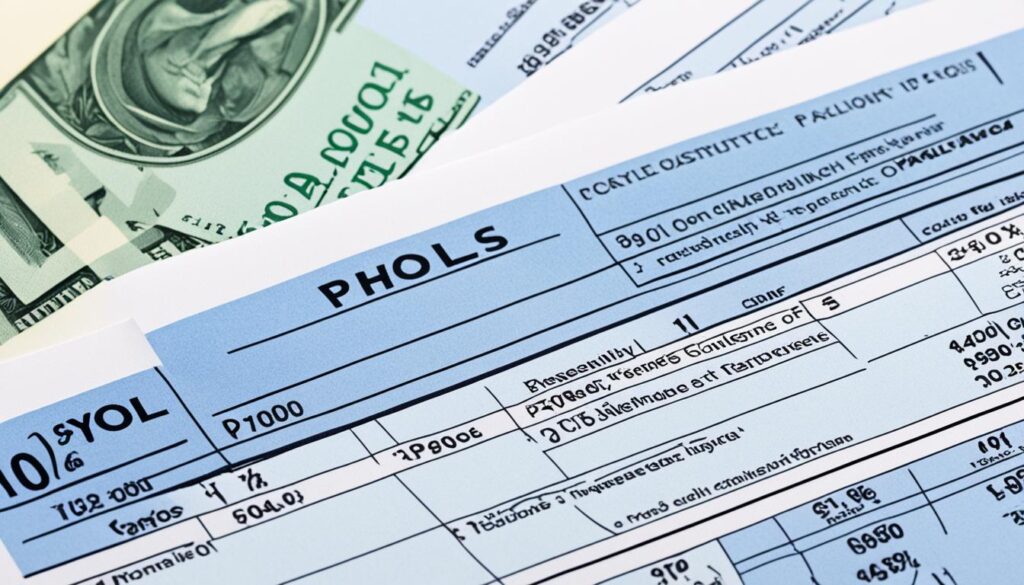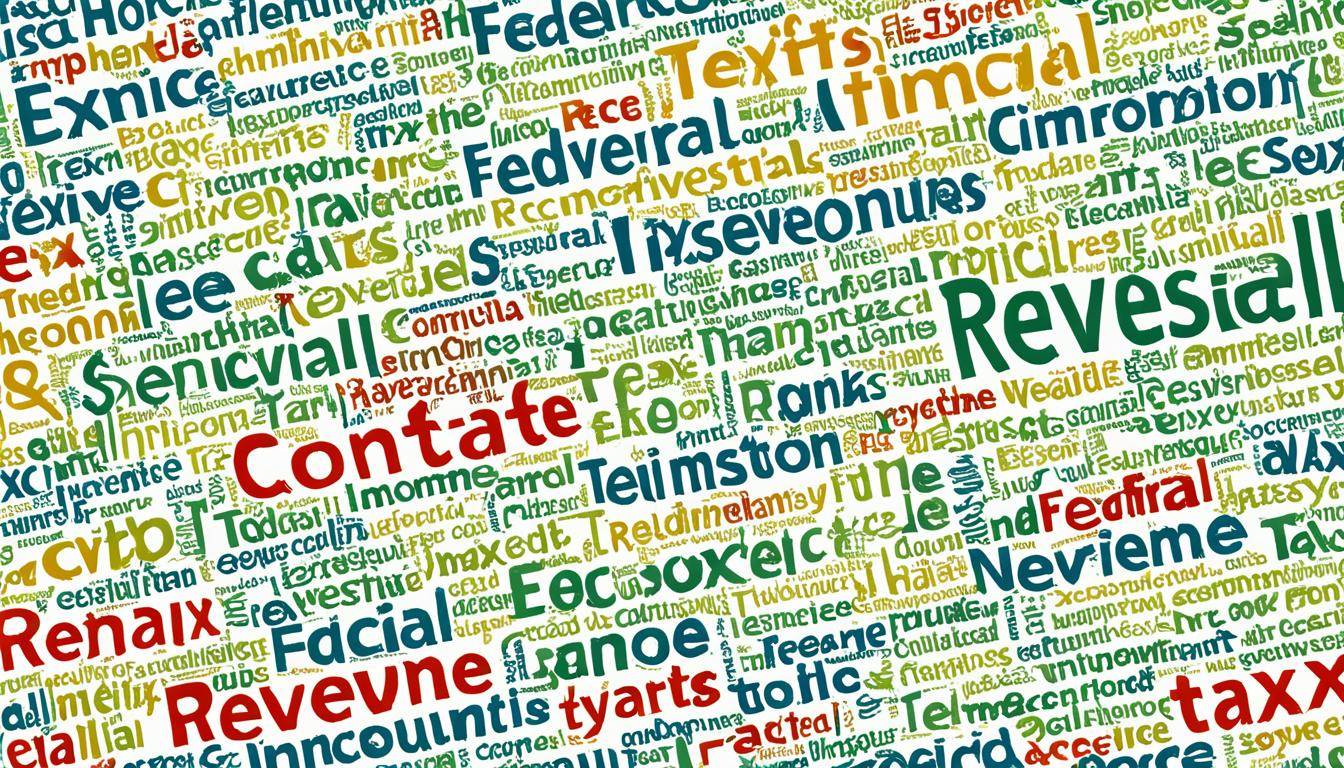The of the U.S. involves collecting and spending money for public programs. The federal government gets its money from various taxes. But, some taxes have become more important over time. Knowing these main tax sources helps understand government policies and their effects.
In 2022, the federal government got $4.9 trillion. This was about 19.6% of the GDP. The has been the top source of money since 1944. It made up 54% of all funds in 2022. This amounted to 10.5% of the GDP. On the other hand, revenue used to be higher. However, it only added up to 9% of the government’s income in 2022. This has fallen from 3.7% of the GDP in the 1960s to 1.7% in 2022.
for Social Security and Medicare were 30% of the money in 2022. This was about 6% of the GDP. on goods and services brought in 1.8% of the revenue in 2022. This was lower than what it used to be, dropping from 1.7% of the GDP in the late 1960s to 0.4% in 2022. Other small taxes and fees made up the last 5% of the income. This includes , , and some income from the Federal Reserve.
Key Takeaways
- The individual income tax has been the largest source of federal revenue since 1944, comprising 54% of total revenues in 2022.
- Corporate income tax revenue has declined from an average of 3.7% of GDP in the late 1960s to 1.7% of GDP in 2022.
- Payroll taxes that fund Social Security and Medicare made up 30% of federal revenue in 2022, around 6% of GDP.
- Excise taxes on goods and services have fallen from 1.7% of GDP in the late 1960s to 0.4% of GDP in 2022.
- Other revenue sources, such as estate/gift taxes, customs duties, and fees, made up 5% of federal revenue in 2022.
Overview of Public Finance
Public finance looks at how governments manage the economy. It covers how they make money through taxation, and how this money is spent. We study things like government budgets, spending on services, and how they handle debts. Also, it looks at how government actions affect the economy as a whole.
Understanding Public Finance: An Overview
The heart of public finance is how governments get money from people and businesses. They collect different types of taxes and fees. Then, this money goes back into the community to pay for important services and benefit everyone. Things like public projects, social programs, and maintaining a good, reliable economy.
The Role of Fiscal Policy in Economic Stability
Fiscal policy means governments use spending and taxation to shape the economy. Balancing the budget is crucial, working to keep the economy stable and growing. This means making choices on things like budget deficits and managing national debt, all while delivering necessary services. It’s about keeping the country’s finances in good shape for the future.
Types of Taxes in Public Finance
The U.S. government gathers money from many tax sources like income taxes, payroll taxes, and excise taxes. It’s key to know about these tax types. This helps us understand the tax structure and how taxes are spread. It also shows us how tax policy and tax reform plans work.
Income Taxes
Since 1944, income taxes alone made up more than half of government income. Such progressive taxes aim to be fair, taking more from those who earn more. They’re crucial for financing government activities and helping redistribute wealth.
Payroll Taxes
In 2022, payroll taxes for Social Security and Medicare were 30% of what the government earned. They are levied on earnings, and since they’re the same for everyone, we say they are regressive. These taxes help cover the costs of important social programs.
Corporate Income Taxes
Corporate taxes made up 9% of government income in 2022. This share has dropped over the years to 1.7% of GDP. Changes in tax policies and the rise of new business types have driven this drop.
Excise Taxes
In 2022, excise taxes were only 1.8% of what the government earned. They are added to certain goods and services to change how we buy or to earn money for special uses. Their role in government finance has become less important over the years.
Property Taxes
States and local areas mainly use property taxes to get money. The tax amount depends on a property’s value. This type of tax can affect whether housing is affordable and who gets more wealth.
Estate Taxes
When wealth changes hands due to death, the government taxes a part of it with estate taxes. Even though it doesn’t make up a big part of government income, these taxes are debated a lot. Some think they’re good for spreading wealth while others worry about their effect on savings and investments.
| Tax Type | Percentage of Federal Revenue (2022) | Percentage of GDP (2022) | Key Characteristics |
|---|---|---|---|
| Individual Income Taxes | 54% | 10.5% | Largest source of federal revenue, progressive tax structure |
| Payroll Taxes | 30% | 6% | Funds Social Security and Medicare, regressive tax structure |
| Corporate Income Taxes | 9% | 1.7% | Declining share of federal revenue, impacted by policy changes and economic factors |
| Excise Taxes | 1.8% | 0.4% | Levied on specific goods and services, can influence consumer behavior |
| Property Taxes | N/A | N/A | Significant source of revenue for state and local governments |
| Estate Taxes | N/A | N/A | Controversial topic in tax policy debates, tied to wealth redistribution |
Individual Income Tax
Since 1944, the individual income tax has been the government’s biggest revenue source. It made up 54% of all revenues in 2022. In that year, it also accounted for 10.5% of the country’s GDP. This tax plays a key role in funding public services and programs.
Largest Source of Federal Revenue
In 2022, individual income tax revenue hit a record high. This was more than any other time, even beating the early 2000s when the economy was strong. After the Great Recession, in 2010, this revenue dropped to just 6% of GDP. But since then, it has grown to an average of 9.6% of GDP each year.
Progressive Tax Structure
The U.S. uses a progressive tax system. In this system, the more money you earn, the higher your tax rate is. The aim is to share the tax responsibility fairly. It helps in other ways too, like in making sure people follow the tax rules and in taking care of the taxpayers’ needs.
But, this system is not without its flaws. For instance, some people might try to avoid paying the right amount of tax. This is called tax evasion. Over time, there have been calls to make the tax system simpler. This way, everyone knows where they stand and how much tax they should pay.
Looking to the future, the Congressional Budget Office predicts a drop in tax revenues by 2025. They think these revenues will hit 8.8% of GDP. But, they expect it to bounce back to 9.6% in the years that follow. These predictions show the ongoing challenge of managing the country’s budget and the tax system.
Public Finance and Government Spending

The federal government funds many programs to help Americans. This includes things like national defense, building roads, and offering social services.
Governments work hard to spend money wisely. They decide how to divide resources among different areas. With a strategy in place, they aim to get the most from the money they spend.
Allocation and Efficiency of Government Spending
Finding the best way to use public money is very important. Governments study what it costs and what it gives back. They look for ways to do more with less, improving how government services work.
Provision and Financing of Public Goods
National defense, building things like roads, and social services are vital to public life. Everyone benefits from these, but few can keep others from doing so too. This key role of government is known for its wide-reaching benefits.
However, governments need to juggle this with other money needs. They use various methods, like taxes and loans, to ensure these services keep going.
Social Insurance and Payroll Taxes

In 2022, payroll taxes on wages funded 30% of federal costs. This includes Social Security and Medicare. They made up a big part of government money. Since 1950, their share has grown a lot. The start of Medicare and more taxes on Social Security increased their share. They went from 1.6% of the economy to over 6.0% by the 1980s.
Social Security and Medicare Funding
In 2011 and 2012, due to a financial crisis, Social Security tax contributions decreased. This reduction caused the government’s income from these taxes to drop to 5.3% of the economy. However, it has since picked back up to 6.0%. These payroll taxes support Social Security and Medicare. These are key for millions of Americans, offering retirement, disability, and health benefits. They are vital government social programs.
Trends and Impacts of Payroll Taxes
Over the years, the percentage of social insurance receipts from GDP has increased. This shows how important these payroll taxes have become. They help pay for Social Security and Medicare. As the U.S. ages and healthcare costs go up, so does the tax burden from these taxes. It’s a challenge for the government’s finances and long-term economic impacts of our population’s age.
Corporate Income Taxation

In 2022, the tax on corporate profits made up 9% of the money going to the federal government. Since the late 1960s, corporate income taxes have dropped from an average of 3.7% of GDP to just 1.5%. However, recently, this tax’s share of the GDP went up to 1.7% in 2022.
Trends and Implications of Corporate Tax Rates
The lower amount of money from corporate taxes comes from lower tax rates and more businesses avoiding this tax. These changes affect how much tax money the government collects and who pays the most tax.
Tax Policies and Business Incentives
When setting tax rules, leaders need to think about the impact on businesses, like if they’ll invest more or be globally competitive. Good tax policies can help companies grow, use resources better, and keep a strong presence at home.
Public Finance and Debt Management
The national debt is the money the federal government has borrowed. This borrowing covers expenses that have built up over time. The government borrows more money when it has a deficit, adding to the debt. Activities like changes in the Treasury’s cash and federal student loans also affect the national debt.
National Debt: Causes and Consequences
The national debt poses a big problem for public finance. It has wide-ranging effects on the economy. When the government spends more than it makes, this creates budget deficits. These deficits are a key reason why the national debt keeps growing. There are several reasons for these deficits. They could be from more spending, tax cuts, or economic downturns. All these lead to a bigger public debt.
Debt Sustainability and Management Strategies
Keeping public debt at a sustainable level is key for good financial management and stable economies. Governments should use smart debt management tactics. These include how they structure their debt repayments, the sources they get their funds from, and reducing debt over time. Things like cutting spending and growing the economy are vital. So is managing debt payments well.
Revenue Generation Strategies

To manage money well, governments must come up with smart tax plans. These plans should bring in enough money to pay for public needs and push forward government goals. Making changes to how taxes work, like rates and who pays, is always a work in progress.
Tax Policy Design and Reform
When deciding on new tax rules, policymakers need to be smart. They want to make sure they get a lot of money in taxes. But they also don’t want to hurt the economy. It’s important to design the tax system in a way that is fair and clear. This should make it easy for people to pay their taxes and less tempting to try to avoid them.
Maximizing Tax Revenue and Efficiency
Getting a lot of money through taxes, but doing it in a smart way, is high on the agenda. Policymakers check how taxes affect the economy and people’s choices. They also look at things like tax breaks and how competitive their taxes are for both businesses and people. It’s not just about the rules; it’s also about making sure everyone follows them so the government has the money it needs for the public good.
When countries set up taxes well and keep tweaking them to meet money-making goals and promote a strong economy, everyone benefits. This way, the government can run smoothly and do the good things people need it to do.
Public Finance

Public finance studies how the government impacts the economy. It looks at how the government collects money through taxation. It also studies how this money is spent on expenditures. Understanding the government’s role in the economy is essential. It covers things like why the government gets involved, and how it shares resources.
The Economics of the Public Sector
Governments are key in fixing market failure and providing public goods. They fix problems that businesses can’t solve, known as externalities. The framework of public finance looks into why this intervention is needed. It also studies its impact on the economy.
Fiscal Responsibility and Sustainability
Staying fiscally responsible and ensuring the government’s sustainability is a big task. This includes handling budget deficits and public debt. Policymakers aim to keep a stable economy and make fair choices. This is tough to balance with meeting the public’s needs.
Smart use of money and keeping an eye on debt financing is crucial. It helps maintain the government’s financial health over time. Experts look into the smartest ways to manage debt. They think about how it affects everyone.
Intergovernmental Fiscal Relations

Various governments (federal, state, and local) collect taxes. This can be tricky for people earning money in different places. They might end up paying taxes to more than one government.
Federal, State, and Local Taxation
There are many types of taxes at different levels of government. Taxpayers deal with federal, state, and local taxes. This means the governments have to work well together to make things smooth for everyone.
Coordination and Fiscal Federalism
Taxes need to be managed well across all levels of government. This is key for a fair and effective public finance policy. The way money moves between governments plays a big role in the economy.
Policymakers must carefully balance taxes across different government levels. This is vital for a tax system that works well for all. It helps achieve goals like economic stability, better use of resources, and helping people in need.
Public Financial Management
The government uses its budgeting and spending processes to pay for various programs and services. Good budget planning, execution, and management is key. It helps make sure public resources are used well and wisely.
Budget Planning and Execution
To plan the budget well, you have to guess what the income will be and decide where to spend money first. During the budget execution phase, the aim is to spend funds wisely. This means keeping an eye on where the money goes and making changes as needed to get the best use out of it.
Also Read: What Opportunities Exist For Investors In Financial Markets?
Enhancing Public Sector Efficiency
Making the government more efficient is important in managing public money. This means using methods to check how well things are going, making what you do clearer, and reporting on finances. It’s all about finding ways to save money and do better for the people. Doing this earns people’s trust and confidence in how their taxes are used.
| Public Financial Management Objectives | Key Focus Areas |
|---|---|
| Effective Budget Planning and Execution |
|
| Enhancing Public Sector Efficiency |
|
| Promoting Public Accountability |
|
Conclusion
Public finance is a key area that looks at the government’s part in the economy. It studies how the government collects money through taxes. It then spends this money to meet various goals. Within this field, we see different types of taxes. These include taxes on income, what we earn, what companies make, and more. All these types of taxes help the government have money to spend.
To manage public finance well, the government must carefully balance its spending and income. It aims to be both financially responsible and sustainable over time. Leaders have to handle complex tasks. These include deciding how budgets are used between different government levels. They also focus on making public services run better. This way, they can make the best use of money from taxes.
The face of public finance is always changing. Understanding the effects of taxes and how they are used is getting more and more important. As we move forward, choosing to tax and spend wisely is key. It promotes a steady economy and supports growth. Plus, it makes sure the public gets good services.
FAQs
What are the main sources of taxation in public finance?
Taxation in public finance comes from several places. This includes income taxes, both for individuals and companies. There’s also payroll taxes, which are taken out of your paycheck. Excise taxes, property taxes, and estate taxes are major sources too. These taxes collect money for the government to use on public needs.
What is the role of fiscal policy in economic stability?
Fiscal policy involves what the government spends and collects in taxes. It helps keep the economy stable and growing. For example, it can increase spending to help when the economy is slow, or reduce it to fight inflation.
What are the different types of taxes in public finance?
Different taxes serve various purposes in public finance. You have income taxes for people and companies. Then, there are payroll taxes, excise taxes, property taxes, and estate taxes. Each tax type works differently and affects the economy in its own way.
What is the role of the individual income tax in federal revenue?
Since 1944, the biggest part of the government’s money comes from individual income taxes. They made up 54% of all tax revenue in 2022, 10.5% of the country’s GDP. This shows how important these taxes are for the government’s budget.
How do governments allocate and manage public expenditures?
Governments plan their spending very carefully to make sure it’s used well. They pay for things like national defense, building roads, and helping people in need. This is how they manage our tax money to provide what we need.
How are social insurance programs funded through payroll taxes?
Social insurance, like Social Security and Medicare, are funded mainly by payroll taxes. These taxes add up to 30% of the government’s income. As these programs grow, so does the importance of these taxes.
What are the trends and implications of corporate income taxation?
The money from company taxes has been dropping. In the late 1960s, it was at 3.7% of the GDP. Now, it’s just 1.5%. This change is due to new policies and the economy. It’s a big deal in how the government plans to spend our money.
How do governments manage public debt and ensure fiscal sustainability?
Balancing what the government spends and earns is tricky. So is dealing with debt. But, it’s very important for the government to keep a good financial plan. This way, they can make sure the country’s finances are strong for the future.
What are some strategies for maximizing tax revenue in public finance?
To make more tax money, the government needs smart policies. They have to be fair, improve how people follow the rules, and stop tax cheating. This helps the economy work better and keeps things fair for everyone.
How does the economics of the public sector influence public finance?
Public sector economics looks at why and how the government steps in. It also looks at what it spends money on and how it spreads resources. Understanding this helps the government make good financial decisions that meet people’s needs.
What are the key considerations in intergovernmental fiscal relations?
Making different levels of government work together is very important. They need to agree on who pays for what. This sharing and agreement impact the economy too.
How do governments ensure efficient public financial management?
To use our taxes well, governments must plan their budgets well and spend money carefully. They need to be open about how they use money and be responsible for it. This helps the country get the most out of its financial resources.





